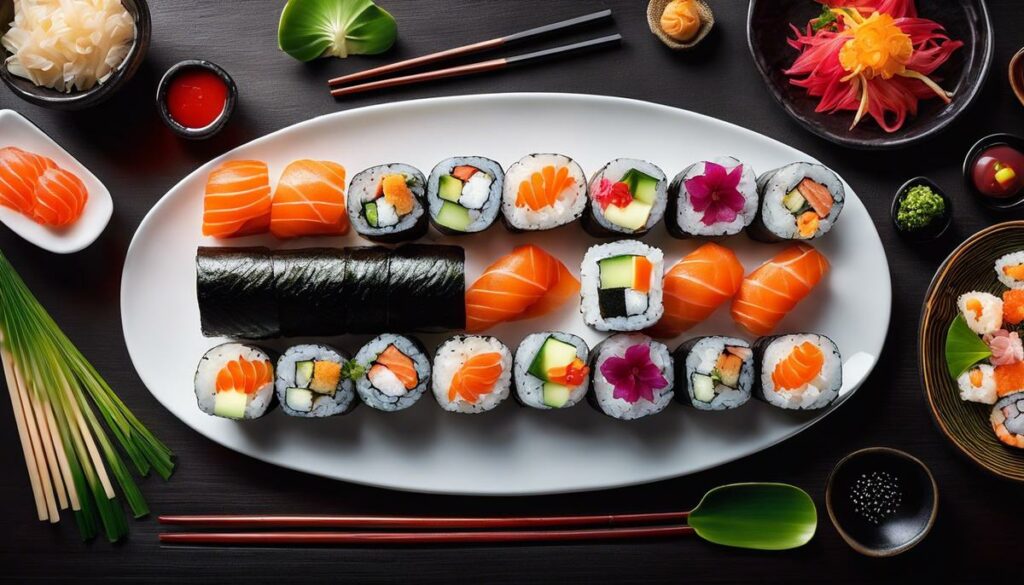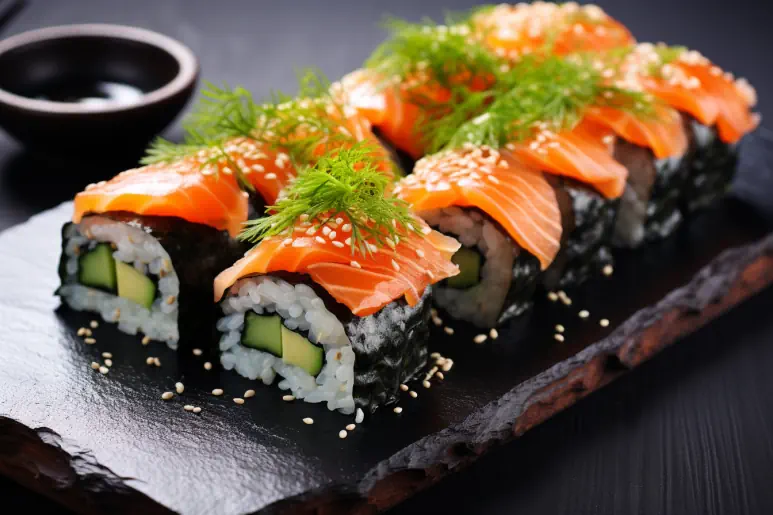The art of sushi is far more than just preparing a delicious meal; It is a form of expression that is pleasing to both the eye and the palate. Sushi plating, the art of creatively arranging sushi, turns this already sophisticated dish into a true feast for the senses. Immersed in the fascinating world of sushi plating, this essay is an introduction to the subtle art of sushi plating by beginning to shed light on the appropriate use of color and texture in presentation and the role of seasonal ingredients.
The Fascination of Sushi Plating: The Adequate Use of Colour and Texture
When it comes to the demanding craft of sushi plating, color and texture play an essential role. They attract the eye and add an aesthetically pleasing feel to any meal.
Sushi is an indelible part of the culinary lifestyle, combining craftsmanship and taste in never-before-seen forms. With the right use of color and texture, sushi plates can become true works of art.
First, let’s focus on the color. Colour is a versatile element that can arouse emotions and accentuate the sense of taste. Sushi plating offers a plethora of ways to use light to bold colors. In the world of sushi, the contrast between the white rice and various toppings – from bright raw fish, green seaweed to pink pickled ginger – creates a palette that pleases the eye.
Now let’s switch to texture. Texture adds a sense of depth and adds a touch of sophistication to even the simplest dishes. The contrast between the smooth, cool fish and the sticky, warm rice creates a variety of textures that offer a true feast of sensations when you bite.
But it’s not just the sushi itself that can provide color and texture. Serving sushi on minimalist earthenware platters or traditional Japanese “geta” boards can enhance the aesthetic experience even further. Even the choice of chopsticks, from glossy black lacquer to natural bamboo, can significantly affect the overall look.
The skilful partnership of color and texture in sushi plating is the key to a delightful dining experience. The motto is: Be creative, be bold, but most importantly, be yourself. Because as in life, beauty is to be found in the details and in the unique. It’s time to take your sushi experience to the next level. Who knows what fascinating new avenues this artful form of presentation will open up?

Importance of Seasonal Ingredients in Sushi Plating
An essential aspect that characterizes sushi plating is, without a doubt, the use of seasonal ingredients. Not only do they serve as an aesthetic addition, but they also contribute to the flavor profile and freshness of a dish. Nevertheless, their importance and use is often underestimated and unknown.
The art of sushi plating brings together numerous elements of Japanese aesthetics and culture . The philosophy behind these beautiful dishes is that the food should first be enjoyed with the eyes . Seasonal ingredients play an important role in this, as they reflect the colors and ambience of the current season.
Taking advantage of seasonality in sushi preparation is based on the Japanese tradition of Miketsukuni, which focuses on gathering and preserving food in its respective seasons in order to maximize its freshness and quality. For example, salmon caviar is processed in autumn, sea bream in spring or sea urchin in summer .
The advantage of using seasonal ingredients in sushi plating is that they are not only able to enhance the dining experience, but also enrich the texture and color palette of the dish. In addition, they help to create a connection with nature and the current season, which ultimately contributes to the overall experience.
In order to make the best use of seasonal ingredients, you should first understand their properties . Make sure they are fresh and of good quality , as they will have a direct impact on the taste and presentation of the sushi. Another aspect to keep in mind is that each ingredient is unique and therefore will play its own role within the dish.
Especially in the world of Instagrammable food, the aesthetic appearance of a dish plays a decisive role. By using seasonal ingredients in sushi preparation, not only the taste but also the visual experience can be enhanced. This makes sushi not only a delight for the palate, but also a work of art that delights the senses.
In conclusion, the importance and effective use of seasonal ingredients in sushi plating should not be underestimated. Not only do they help improve the taste and texture , but they also help create an aesthetically pleasing dish that combines the pleasure of the palate with the presentation. In this way, the experience of eating sushi is made a holistic experience that is enjoyed on several sensory levels.

Finishing touches in sushi plating: presentation and style
Starting a new sushi plating is like creating a living canvas. Of central importance is the careful selection and arrangement of seasonal ingredients, which bring not only taste and freshness, but also visual variety and artistic quality to the presentation.
The Japanese art form of Miketsukuni, which emphasizes the practice and honoring of gathering food according to the season and region, is given great importance in modern sushi plating. It offers orientation with its philosophical emphasis on seasonality and anchoring in the environment. For example, green asparagus and strawberries are often used in sushi creations in spring, while mushrooms and chestnuts set the gastronomic accent in autumn.
Using seasonal ingredients is a stylish way to fuse art and flavor and add value. It expands the culinary experience, enriches the texture and expands the color palette. In addition, it creates a connection to the current season and nature, which represents a relevant added value for conscious haute cuisine.
Another great aspect that should not be overlooked when designing sushi platings is the world of Instagrammable food. Visual appearance has become highly valued in modern cuisine, as it is often the first thing a potential customer sees. The rule is: We eat with our eyes first.
In this context, sushi is transformed into a visual work of art that invites not only to eat, but also to photograph and share on social media. Seasonal ingredients play a key role here, bringing variety, color and uniqueness to the presentation and enhancing the visual appeal.
To make the most of the seasonal ingredients, they should be carefully selected and placed to achieve harmony and balance on the platter. Attention is paid to complementarity and the subtle play of colours, shapes and textures to create a harmonious composition.
Ultimately, sushi plating bundles a well-rounded gastronomic experience: it captivates the eye, awakens the senses and offers a variety of tastes and textures. It combines the pleasure of enjoyment with the elegance of a presentation that reflects the culinary style and artistic expression of the chef.

In conclusion, the art of sushi plating requires a precise and creative skill that goes far beyond simply rolling and slicing sushi. The selection and placement of colors and textures, the consideration of seasonal ingredients, and the final presentation all play an essential role in creating a culinary work of art. Ultimately, the resulting style emphasizes aesthetic unity and coherence, reaffirming the importance of first impressions. As this art form continues to be perfected, it is clear that sushi plating offers a sensory experience that is both visually intriguing and culinarily enjoyable.


